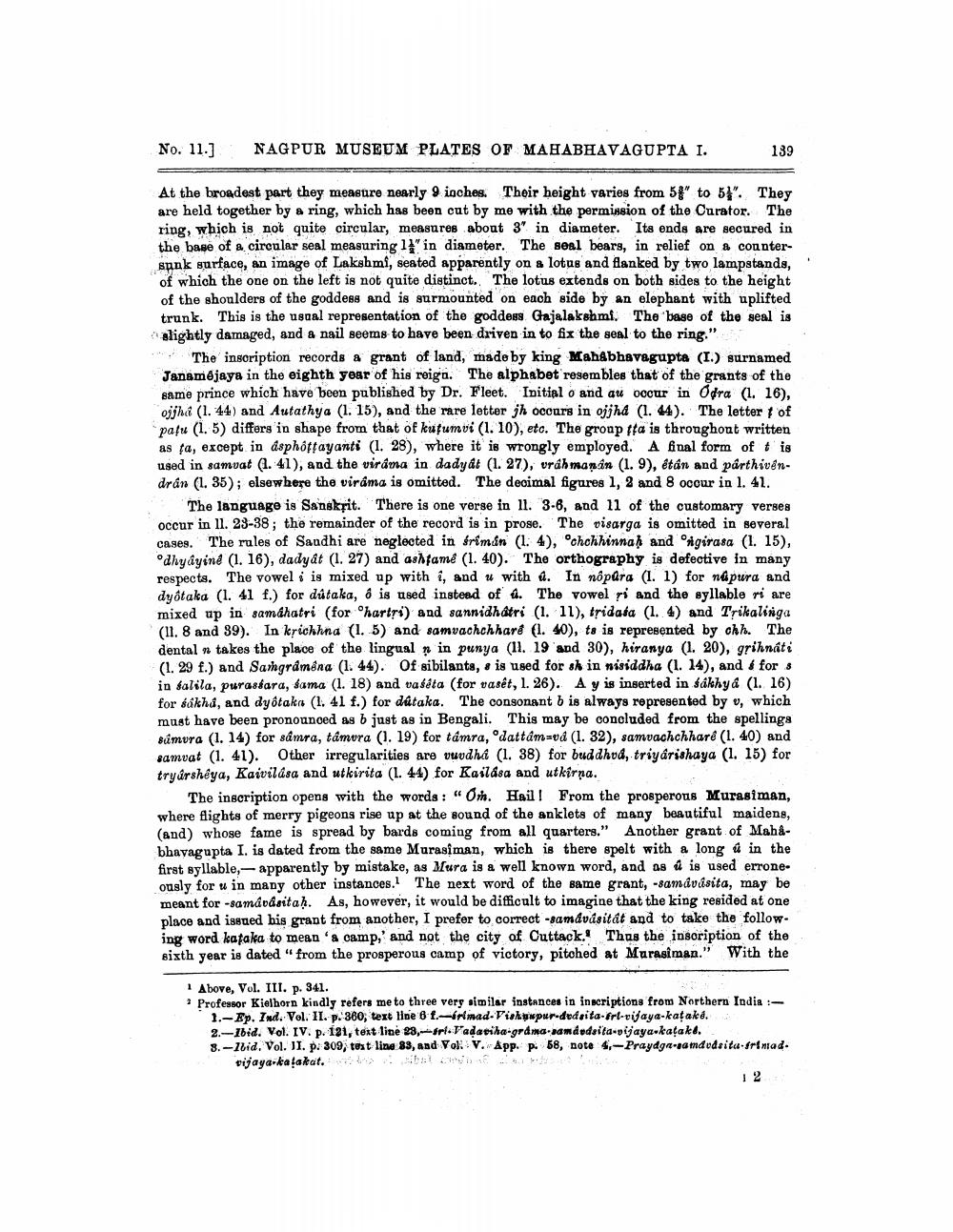________________
No. 11.]
NAGPUR MUSEUM PLATES OF MAHABHAVAGUPTA I.
139
At the broadest part they measure nearly 9 inches. Their height varies from 5%" to 51". They are held together by a ring, which has been cat by me with the permission of the Curator. The ring, which is not quite circular, measures about 3' in diameter. Its ends are secured in the base of a circular seal measuring 11 in diameter. The seal bears, in relief on & connterspnk surface, an image of Lakshmi, seated apparently on a lotus and flanked by two lampstands, of which the one on the left is not quite distinct. The lotus extends on both sides to the height of the shoulders of the goddess and is surmounted on each side by an elephant with uplifted trunk. This is the usual representation of the goddess Gajalakshmi. The base of the seal is slightly damaged, and a nail seems to have been driven in to fix the seal to the ring."
The inscription records a grant of land, made by king Mahabhavagupta (I.) surnamed Janamêjaya in the eighth year of his reiga. The alphabet resembles that of the grants of the same prince which have been published by Dr. Fleet. Initial o and au occur in Odra (1. 16), ojjha (1. 44) and Autathya (1. 15), and the rare letter jh occurs in ojjha (1. 44). The letter of patu (1. 5) differs in shape from that of kutumvi (1. 10), etc. The group ta is throughout written as ţa, except in asphottayanti (1. 28), where it is wrongly employed. A final form of t is used in samvat (l. 41), and the virama in dadyat (1. 27), vráhmanin (1.9), étán and párthivêndrán (1. 35); elsewhere the virama is omitted. The decimal figures 1, 2 and 8 ocour in l. 41.
The language is Sanskrit. There is one verse in 11. 3-6, and 11 of the customary verses occur in 11. 23-38; the remainder of the record is in prose. The visarga is omitted in several cases. The rules of Saudhi are neglected in sriman (1. 4), ochchhinnah and Agirasa (1. 15), odhyayine (1. 16), dadyat (1. 27) and ashtamé (1. 40). The orthography is defective in many respects. The vowel i is mixed up with i, and u with i. In nopūra (I. 1) for napura and dyōtaka (1. 41 f.) for dútaka, 8 is used instead of a. The vowel ri and the syllable ri are mixed up in samdhatri (for Chartri') and sannidhatri (1. 11), tridata (1. 4) and Trikalinga (11. 8 and 39). In krichhna (1. 5) and samvachchharé (1. 40), ts is represented by chh. The dental n takes the place of the lingual n in punya (11. 19 and 30), hiranya (1. 20), grihnati (1. 29 f.) and Sangråmøna (1. 44). Of sibilants, . is used for sh in nisiddha (1. 14), and 6 for s in salila, purastara, sama (1. 18) and vafeta (for vasét, 1. 26). Ay is inserted in fákhya (1. 16) for sakha, and dyðtakr (1. 41 f.) for dátaka. The consonant b is always represented by v, which must have been pronounced as b just as in Bengali. This may be concluded from the spellings sámura (1. 14) for sdmra, tâmura (1. 19) for támra, "dattám=vd (1. 32), samvachchharé (1. 40) and samvat (1. 41). Other irregularities are vuvdha (1. 38) for buddhud, triyarishaya (1. 15) for tryårshéya, Kaivildsa and utkirita (1. 44) for Kailasa and utkirna.
The inscription opens with the words: “Oh. Hail! From the prosperous Murasiman, where flights of merry pigeons rise up at the sound of the anklets of many beautiful maidens, (and) whose fame is spread by bards coming from all quarters." Another grant of Mahabhavagupta I. is dated from the same Murasîman, which is there spelt with a long 4 in the first syllable,- apparently by mistake, as Mura is a well known word, and as d is used erroneously for u in many other instances. The next word of the same grant, -samdväsita, may be meant for-samdväsitaḥ. As, however, it would be difficult to imagine that the king resided at one place and issued bis grant from another, I prefer to correct -samdvasitát and to take the following word kataka to mean a camp,' and not the city of Cuttack. Thus the inscription of the sixth year is dated" from the prosperous camp of victory, pitched at Marasiman." With the
Above, Vol. III. p. 341. * Professor Kielhorn kindly refers me to three very similar instances in inscriptions from Northern India :
1.- Ep. Ind. Vol. II. p. 360, text lide 8 f irmad-Viskupur-dodrita-fri-vijaya-katakd. 2.-Ibid. Vol. IV. p. 131, text line 28,fri Padariha-grdna.sandudsita-vijaya katakd. 8.-10id. Vol. II. p. 309, text line 83, and Vol V. App. p. 58, note 4,-Praydga-samdvdsita.friniad.
vijaya-kalakat.




